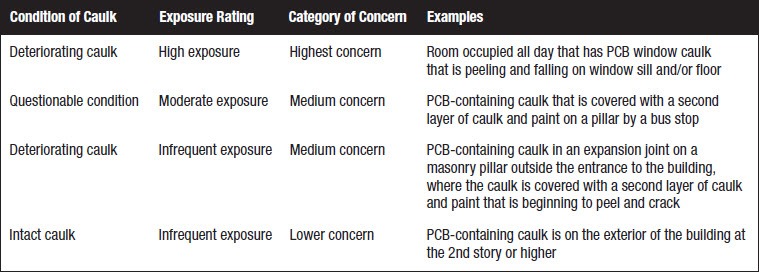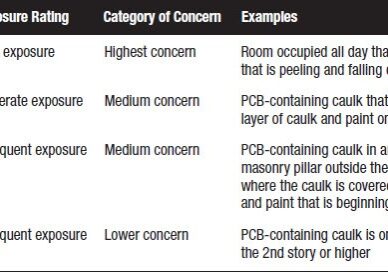Polychlorinated biphenyls, or PCBs, are man-made chemicals that persist in the environment and were widely used in construction materials and electrical products prior to 1978. PCBs can affect the immune system, reproductive system, nervous system and endocrine system and are potentially cancer-causing if they build up in the body over long periods of time.
Caulk containing PCBs was used in some schools during construction and renovation from 1950 through 1978 before PCBs were banned. If such caulk is deteriorating or disturbed, it may present a toxic hazard to staff and students. However, not all caulk contains PCBs and it is not possible to distinguish between non- PCB caulk and PCB caulk without a laboratory test.
Caulk that is intact and in good condition is believed to present a low risk. Exposure to PCBs may occur as a result of their release from the caulk into the air, dust, surrounding surfaces and soil, and through direct skin contact. Such exposure may have been taking place for many decades in affected schools.
The PCB-in-caulk hazard went unrecognized until 2004, and many public schools around New Jersey are likely to still contain contaminated caulk on windows, doorframes, masonry, and joints. Little attention has been paid to this issue in New Jersey by state agencies. To date, the U.S. Environmental Protection Agency (EPA) has done the most work on the issue, creating a webpage with detailed information and recommendations. These are listed in the sidebar.
Upon request, EPA will work directly with school districts facing serious problems. EPA is also conducting research to resolve puzzling scientific issues such as the link between the concentrations of PCBs in caulk and PCBs in the air or dust.
Steps to assess caulk
To assess PCB risk, school districts should take these steps in each building:
- Assess the age, location, and condition of the caulk. Areas that should be assessed include:
- Caulk used to seal windows and expansion joints. Note any areas where caulk is peeling, cracking, brittle or deteriorating, or has been removed and replaced from a past renovation.
- Caulk found inside the building on the floor, window sills, ledges, concrete joints, or other areas.
- Outdoor areas where any caulk is found on the ground or where peeling caulk is seen. This may be of particular concern if the caulk is on the exterior of the building where it may have affected the soils, particularly if there are routinely used areas nearby, such as gardens, play areas, bus stops and student pick up areas.
- Indoor halls and common use areas, including school classrooms, particularly if the walls are rough masonry and there appears to be the potential for caulk to peel and fall to the floor or to be touched or peeled away by a child or adult.
Determine the potential for frequency and duration of human exposure to the caulk. For each place at the school where there is caulk, consider the frequency (how often the contact occurs) and duration (length of time of each contact) of exposure.
Recording the assessment
The chart below provides simplified examples of the potential concern level when PCBs are found in caulk and/or the surrounding areas. Districts should create a record of their assessments that includes assigning these categories to their findings.

Local association action plan
- Local associations should work with their UniServ field rep to ensure that districts follow EPA’s recommendations on PCBs in caulk:
- Become familiar with the information on the EPA PCBs in Caulk webpage.
- Assess the age, location, and condition of caulk in school buildings.
- If peeling, brittle, cracking or deteriorating caulk is found, take immediate actions to reduce potential exposures to school staff and students.
- Test deteriorating caulk for the presence of PCBs and remove the caulk if PCBs are present at significant levels. Alternately, the district can assume PCBs are present and proceed directly to remove deteriorating caulk.
- Require contractors to follow EPA guidance to prevent disturbing caulk during renovation and demolition.
- Consider testing to determine if PCB levels in the air exceed EPA’s suggested public health levels.
- If serious PCB problems are encountered, contact Jim Haklar, EPA Region II PCB Coordinator to request assistance: 732-906-6817, haklar.james@epa.gov.
EPA PCBs in Caulk Resources
- PCBs in Caulk homepage www.epa.gov/pcbsincaulk/
- Factsheet for Schools and Teachers www.epa.gov/pcbsincaulk/caulkschool kit.htm
- Contractors: Handling PCBs in Caulk during Renovations www.epa.gov/pcbsincaulk/caulk contractors.htm
- Testing for PCBs in Buildings www.epa.gov/pcbsincaulk/caulk testing.htm
- Interim Measures for Assessing PCB Risk and Taking Action to Reduce Exposures www.epa.gov/pcbsincaulk/caulk interim.htm
- Removal and Clean-Up of PCBs in Caulk and PCB-Contaminated Soil and Building Material www.epa.gov/pcbsincaulk/caulk removal.htm
- Public Health Levels for PCBs in Indoor School Air www.epa.gov/pcbsincaulk/max concentrations.pdf
